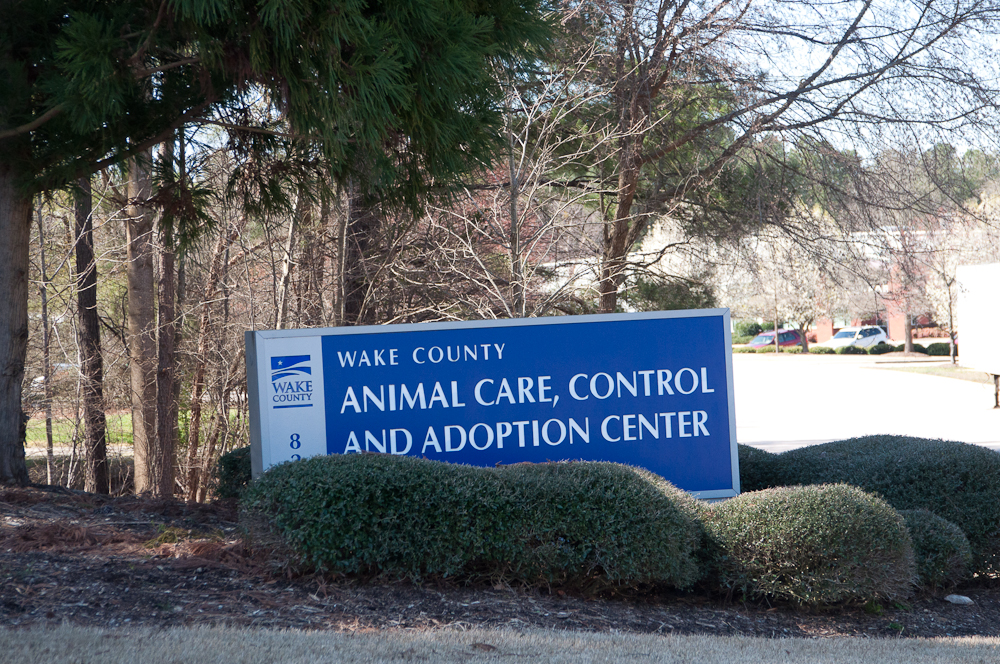Editor’s Note: This is part one of a two-part story.
Representatives from some area animal rescue groups are fed up with the Wake County animal shelter, concerned about policies, the lack of policies in place and an overall sense that things are not going well.
Yet animal shelter leaders are touting transformation this year, taking action by hiring a new director and working with a consultant to review the policies and procedures on everything from behavior assessments to euthanasia.
Some say it’s a change that’s long overdue, but they remain skeptical after years of little communication and what they say were bad policies that led to higher euthanasia rates.
The Beginning
The Wake County Animal Center is located on Beacon Lake Drive in Raleigh. The shelter has a $2.8 million budget.
From May 2011 to June 2012 the shelter was operated by one permanent director and three other temporary directors, which led to confusion, according to the current shelter director Jennifer Frederico, who was hired in May 2012.
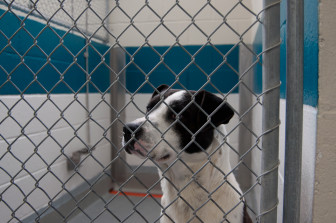
Jennifer Wig / Raleigh Public Record
“I inherited a lot of things that were up and down,” Frederico said. “Although a lot of policies and procedures are known, a lot of things weren’t written down and captured in writing.”
Not everyone knew the policies, she said. Her goal now is to make things more stable.
The first step was to hire a consultant to review those policies and procedures. The county is paying Jyothi V. Robertson of JVR Shelter Strategies $30,000 to do a three-phase assessment of the shelter. She began in October, visited the shelter three times in different months, and will soon complete her review.
The expected final report will include most aspects of the shelter’s operations, staffing, polices and procedures.
Frederico aims to take all of that information and update the shelter. Decisions should be medically based, said Frederico, a veterinarian.
“We’ve made a lot of changes since I’ve come on. A lot of them are medical based,” she said. “Every decision we make here is about the health and wellness of the animals.”
For example, the shelter never used to vaccinate animals upon intake.
“There’s no way to keep your population healthy unless you’re taking care of them on their way in the door,” Frederico said.
Frederico said the changes were inspired by a combination of factors. A new environmental services director, Joseph Threadcraft, was hired in 2012. Then, when Frederico was first hired, she worked as a veterinarian. She witnessed many things she wanted to change. The interim directors weren’t veterinarians, so when Threadraft sought a director, Frederico applied.
“All the questions posed to us were all vet related,” she said. “So the person speaking for the center really needed to be a veterinarian.”
Rescue Groups Push Change
The changes are much needed, according to Heidi Miller, of HEART Pet Rescue. The 501(c)3 animal rescue group picks up dogs from the shelter and works to find homes for them. In some cases, the dogs aren’t friendly or calm enough to be adoptable, but shelter volunteers with proper training can take them and rehabilitate them over time.
Miller said she experienced many problems with the Wake County animal center in late 2011 and early 2012, especially with the center’s euthanasia and aggressive dog policies.
Miller said she has witnessed two specific dogs being put down despite HEART’s attempts to take the animal. The animals were considered aggressive, Miller said, “even though they were sitting in her lap and friendly.”
“The shelter, in my opinion, didn’t show good faith,” Miller said.
Miller was informed that the county’s aggressive dog policy dictates that any dog showing aggression must be euthanized. So in January, she sought county leaders in an attempt to learn more about how she could help.
When requesting copies of the policies and procedures, Miller was told there is no such set of documents. One shelter employee told Miller she not know the shelter had an aggressive dog policy.
Miller then repeatedly requested copies of the aggressive dog policy, the county attorney’s interpretation of the policy and evaluation of the facilities conducted in 2011 and 2012. She even met with county leaders in January, but never received those documents. She said it was a frustrating experience that left her feeling even worse about the state of the animal shelter.
“When you start off a meeting with ‘you can submit a public records request for that information,’ that tells me all I need to know right from the start about how open you are to this communication,” Miller said of her meeting.
Frederico acknowledges the shelter is in dire need of reorganization, but said she’s ready to make those changes.
“I had these ideas. I’m really insistent when I get an idea and I want to see it happen,” she said. “And it’s easy for me to explain a lot of this stuff because I have the medical background.”
Euthanasia Rates
From January 2008 to June 2011 about 8,200 dogs and 15,600 cats were euthanized.
According to reports from the animal shelter, 59 percent of shelter animals were euthanized in fiscal year 2010. That figure dropped to 46 percent a year later, but increased again by 18 percent in the second half of 2011 and increased again in 2012 to 52 percent.
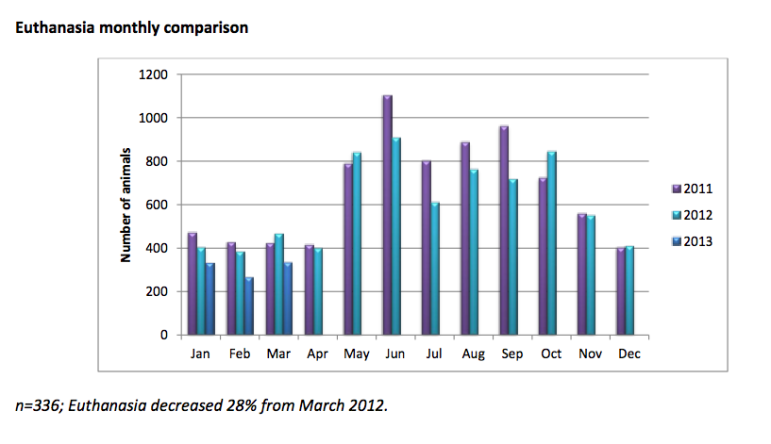
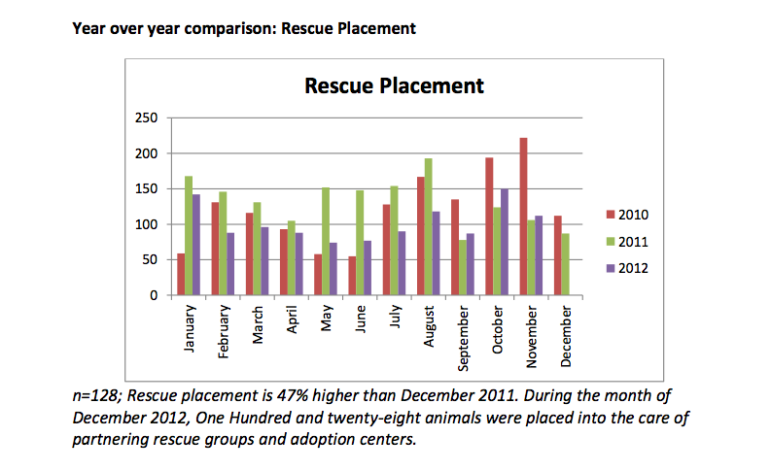
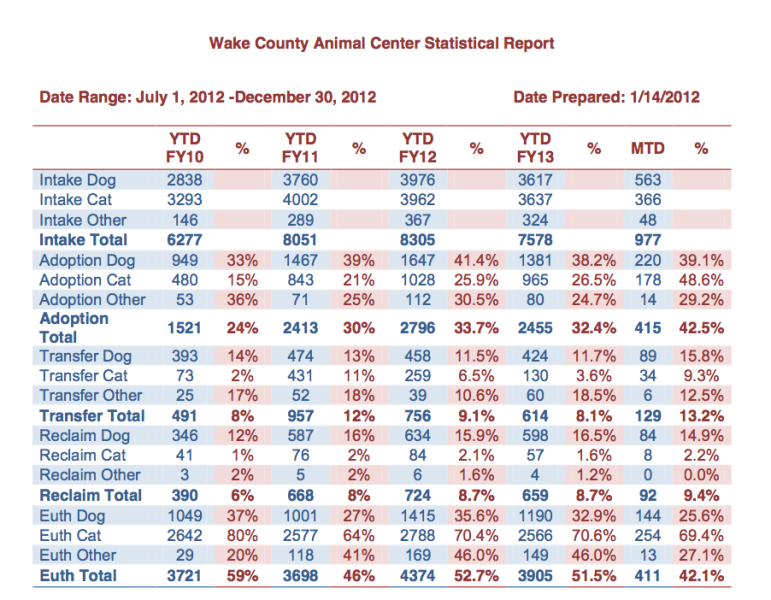
Most of the impending changes are aimed at improving life for the animals and decreasing the euthanasia rates, Frederico said. For example, before Frederico started, animals with upper respiratory infections were euthanized. Such infections can spread quickly, affecting an entire shelter. In November 2011 shelter vets began treating those cases.
Frederico said she’s creating a capital improvement proposal so the shelter can have one room for treating upper respiratory for cats and dogs which, she said, “will be fabulous.”
“Everything in the past used to be black and white, especially with upper respiratory, with what animals could go on the floor versus what could go to rescue,” Frederico said. “We’ve loosened that up a little so we can save more.”
She’d also like a behavior room someday where staff can complete behavior assessments on animals to determine whether they are adoptable.
Those behavior assessments are one issue Miller, with the rescue group, felt needs attention. Animals displaying aggression are considered unadoptable and are euthanized.
Aggressive Behavior
Miller was previously told animals are tested for aggressive behavior based on how they respond to medical treatment. Animals are given injections and dewormed when they enter the facility. If a dog doesn’t allow that treatment to occur, it is declared aggressive. If it’s a dog owned by someone, it’s allowed time to calm down.
Miller said testing animals for aggression when they are being poked and prodded by strangers in a strange environment doesn’t make sense.
“They’ve just been ripped from their family; they’ve just been thrown into a crazy environment, they’re terrified,” she said. “You just have to give them time to adjust to what’s happened to them.”
There’s a ton of little dogs out there and you have no idea what their circumstances are,” Miller said. “Some haven’t even been out of the house.”
Frederico agrees some dogs just need some time, calling it “cage rage.”
“It’s just barrier aggression. Once you get out they’re totally fine. Those dogs are not going to show well on the floor, but once you get them out, they’re fine.
“If they lunge at you, that’s … no. Unfortunately, we’ve had some of those dogs,” Frederico said.
She said staff members now conduct behavior testing recommended by the American Society for the Prevention of Cruelty to Animals, (ASPCA) called a SAFER assessment. Tests take 30 to 40 minutes and include gently squeezing an animal’s feet, playing a game of tag and more. Those who conduct the tests are trained to do so and are working toward achieving certification in the assessments.
“We’ve been behavior testing up the wazoo,” Frederico said. “In the past, I don’t know if they always did them or as frequently.”
Frederico said some dogs who don’t test well are still OK to be given to rescue groups, many of which offer behaviorist training.
From Miller’s perspective, part of the problems stem from the county attorney’s interpretation of the adoption policy, which she said omits the possibility of transfer to rescue groups who can rehabilitate aggressive dogs.
“In terms of what they can do, the ordinance is talking about adoption, not transfer of these animals. Once you change that definition of adoption to include transfer, you’ve just eliminated the ability to transfer a dog to a rescue group,” Miller said. “So he has decided to kill more dogs by changing his interpretation of that code.”
Most of the shelter policies were last updated in 2004. Frederico said the aggressive dog policy is “a work in progress.” She agreed it is open to interpretation and said it is part of the many changes taking place with the help of the consultant.
“Nothing is absolute right now,” she said.
